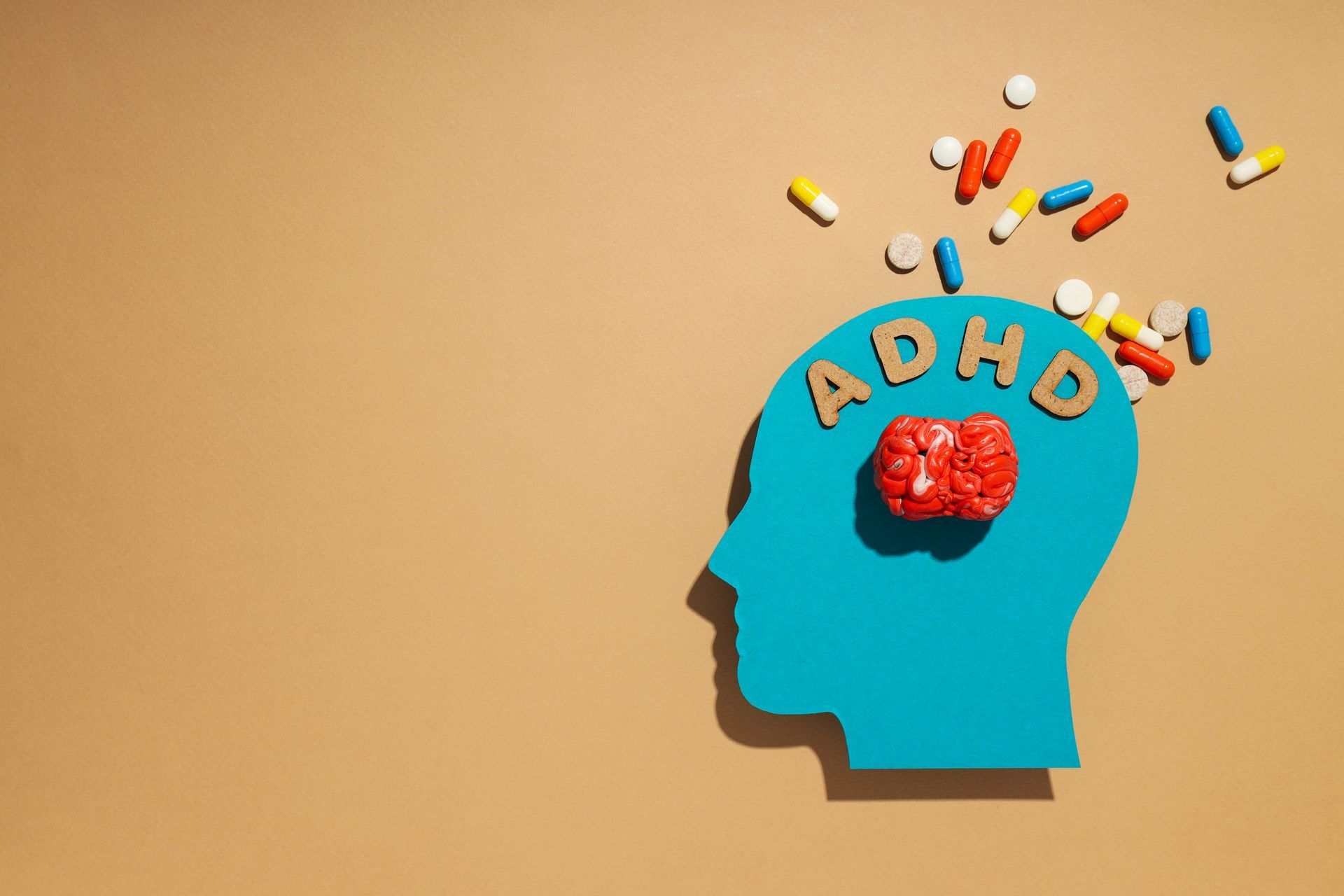Understanding and Managing Attention-Deficit/Hyperactivity Disorder (ADHD)

By Thrive Wellness Sacramento Interim Executive Director & Psychiatrist Jaime Avra Ley, M.D.
Almost 10% of children and about 4% of adults in the U.S. struggle with attention-deficit/hyperactivity disorder (ADHD), a condition that diminishes one’s ability to focus, feel at ease, and control impulses. The distressing disorder can interfere greatly with daily life, but a variety of clinical interventions can help make ADHD more manageable.
WHAT IS ADHD?
ADHD is characterized by difficulty regulating a group of important brain processes, called executive function, responsible for:
- Attention
- Organization
- Working memory
- Control of emotional and physical behaviors
Executive function prioritizes information by encouraging focus on information deserving attention and allowing less important data to fade to the background. These mental processes also help regulate behaviors by allowing or inhibiting actions, a process called impulse control.
Three types of executive function deficits correspond to three types of ADHD:
- ADHD, predominantly inattentive : Difficulty with attention, focus, and organization primarily
- ADHD, predominantly hyperactive/impulsive : Difficulty with impulse control and hyperactivity primarily
- ADHD, combined type: Having both deficits in attention and impulse control
Symptoms of ADHD are associated with attention, hyperactivity, and impulsivity.
ADHD symptoms associated with attention include:
- Difficulty paying close attention to details
- Making seemingly careless mistakes often
- Trouble listening
- Difficulty with organization and prioritization
- Feeling reluctant, disliking, or avoiding tasks that require extended focus
- Frequently losing important items
- Becoming distracted easily
- Forgetfulness
ADHD symptoms associated with hyperactivity and impulsivity include:
- Often engaging in fidgeting or squirming
- Trouble staying in one’s seat
- Engaging in physical activity inappropriate for the current environment
- Difficulting participating in leisure activities quietly
- Frequently feeling “on the go”
- Engaging in excessive talking often
- Interrupting frequently
- Difficulty waiting for one’s turn
Risk factors for ADHD include genetic makeup, premature birth , and exposure to drugs and alcohol in utero.
MISCONCEPTIONS ABOUT ADHD
ADHD is frequently misunderstood. A couple of commonly mistaken beliefs about ADHD include:
- Individuals may misperceive those with ADHD as defiant or lazy. In reality, tasks that may seem simple can require much more effort for individuals with ADHD. As a result, those with ADHD may resist undertakings that demand their full concentration.
- When individuals with ADHD present symptoms of impulsivity, others may misperceive them as disrespectful, unruly, or disobedient. While there may be defiance involved in their actions, those with ADHD face more of a challenge restraining their impulses and moderating their conduct. Authority figures may rightfully implement consequences for inappropriate behavior. They may also validate the increased difficulty that those with ADHD face which can help reduce any shame stemming from the condition.
THE CONNECTION BETWEEN ADHD AND PERINATAL MENTAL HEALTH
Pregnancy and caring for an infant generally entail biological changes, diminished quantity and quality of sleep , and feelings of overwhelm — all of which can impair executive function and make organization, focus, and emotion regulation tough. If a new parent has ADHD, the perinatal period can aggravate the symptoms of the condition.
THE CONNECTION BETWEEN ADHD AND EATING DISORDERS
ADHD varies in the ways it affects different types of eating disorders , such as:
- Binge eating disorder (BED) : Characterized by feeling a lack of control when eating as well as difficulty regulating portions, BED can be worsened by ADHD. Executive function deficits associated with ADHD can make it hard to regulate one’s eating behavior.
- Bulimia : Expressed by frequently eating large quantities of food followed by compensatory purging behaviors , bulimia can also be exacerbated by ADHD. ADHD can make controlling the impulse to engage in compensatory actions more challenging.
- Anorexia and avoidant restrictive food intake disorder (ARFID) : Individuals who struggle with ADHD and restrictive eating disorders, such as anorexia and ARFID are often able to easily disregard their hunger cues. If ignored long enough, hunger cues can dissipate. During recovery, these individuals may require additional guidance as they learn to be more mindful of returning hunger cues .
INDIVIDUAL BEHAVIORAL THERAPY FOR ADHD
Individual behavioral therapy allows those with ADHD to strengthen desired behaviors and reduce problematic conduct. Throughout the process, the clinician integrates appropriate goals, incentives, and consequences to help shape the client’s regulation skills.
Therapists can also help with any emotional challenges associated with the disorder. For example, ADHD can contribute to strained relationships as well as diminished work or school performance. Low self-esteem , social skill deficits, anxiety , and depression may result. Therapy can help treat all aspects of the condition, including any co-occurring diagnoses.
FAMILY THERAPY FOR ADHD
For an individual struggling with ADHD, family support can be essential to the successful management of the disorder. A family therapist can guide family members in supporting their loved one with ADHD while also providing them with skills to keep the family dynamic healthy amid the challenge.
ADDITIONAL INTERVENTIONS FOR MANAGING ADHD
A well-rounded approach to treating ADHD is often beneficial.
Some other ADHD management strategies that can complement therapy include:
- School support resources: Schools can provide accommodations for students with ADHD to promote their academic success and behavioral modification.
- Physical activity in nature: Movement and natural environments can provide a calming, restorative experience which can reduce the stress and anxiety that exacerbate ADHD.
- Neurofeedback: A non-invasive procedure, neurofeedback can help a person understand their brain activity and strengthen their brain’s ability to focus, problem-solve, and control impulses.
- Medication: Certain medications can help stimulate the parts of the brain needed for focus, attention, and behavior regulation.
TREATMENT FOR ADHD AT THRIVE WELLNESS
Thrive Wellness’ mental and behavioral health experts specialize in treating individuals of all ages struggling with ADHD, including those facing perinatal ADHD and ADHD that co-occurs with eating disorders . By implementing interventions such as individual and family therapy, medication management, and educational advocacy, our clinicians guide individuals in managing ADHD in a way that promotes attention, organization, and impulse control. To learn more about our therapeutic services , reach out .
While all Thrive Wellness locations offer interdisciplinary clinical teams who collaborate to treat eating disorders, perinatal mood and anxiety disorders (PMADs), and additional mental and behavioral health conditions, programs and services may vary by location.
About the Author
Thrive Wellness Sacramento Interim Executive Director & Psychiatrist Jaime Avra Ley, M.D.
Born and raised in Nevada, Dr. Jaime Avra Ley earned her doctorate in medicine at the University of Nevada, Reno Medical School where she also completed a residency in adult psychiatry and a fellowship in child and adolescent psychiatry. As an established and esteemed psychiatrist, Dr. Ley specializes in working with children and adolescents.
Dr. Ley considers comprehensive wellness to be inclusive of the health of one’s relationship with themself and others. She is passionate about addressing mental health barriers that may interfere with one’s ability to live authentically and reach their innate potential. Dr. Ley believes a multidisciplinary approach to care increases the efficacy of treatment for lasting results and is dedicated to supporting the various aspects of an individual’s well-being by providing diagnoses and medication management as appropriate.
At Thrive Wellness Sacramento, Dr. Ley enjoys working alongside a diverse treatment team of compassionate clinical colleagues to help individuals and families on their path to healing.
The post Understanding and Managing Attention-Deficit/Hyperactivity Disorder (ADHD) first appeared on Thrive Wellness.








